A 1902 step up in firefighting

Climbing the Wooden Ladder of Success: Modernising Auckland’s Fire Brigade
From 1902 the Auckland Fire Brigade operated a horse-drawn Shand Mason Extension Ladder. In the early days of fire-fighting all equipment, including the steam powered engines, were delivered by horse. While the first motorised engine arrived in New Zealand in 1903 it wasn’t until the late 1910s that these engines, with their heavy loads of ladders and pump engines, were able to outpace a team of horses. The Shand Mason Extension Ladder and its four-wheel carriage was part of the 1902 Fire Brigade revamp led by Superintendent Charles Wooley and was a welcomed modernisation of fire equipment throughout the city.
Auckland Fire Brigade early days
The first official Auckland Fire Brigade (AFB) was formed in 1874, with a number of manual pumps available for firefighters. Horses were used to pull heavy equipment, and the
Stations had stables built to house the horses. Prior to 1874, fires had been attended by volunteer groups made up of the general public, police or constabulary, members of the armed services or representatives from insurance companies. Tamaki Makaurau Auckland had seen various volunteer brigades over the decades of the nineteenth century, although these had limited funding, equipment and resources. In the years leading up to 1874, much campaigning and petitioning had been happening, with the result being a funded and coordinated brigade, the Auckland Fire Brigade.
By the start of the twentieth century, unfortunately, the AFB equipment was outdated, and the number of horses had reduced. Funding had dropped, and the basic equipment was only suitable for fires within running distance of the stations or the height of single-story buildings. By 1900, there was a single AFB horse – which was shared with the local cab driver – and most of the ladders, hooks and hoses had to be moved in handcarts.
Tragedy at the Grand Hotel
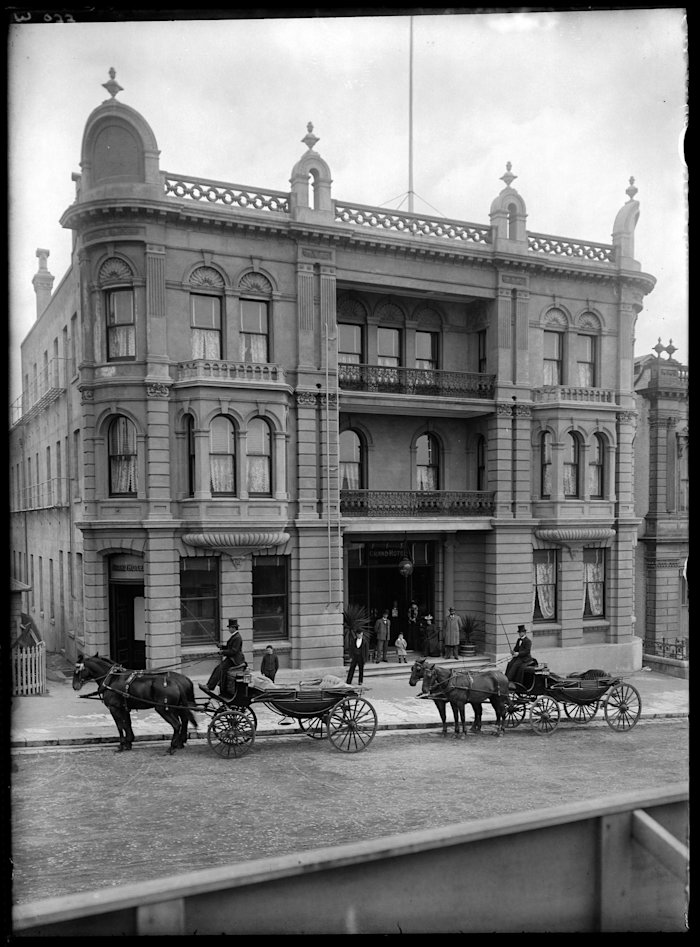
Henry Winkelman. 3rd September 1899. ‘The Grand Hotel Princes Street, 1899.’ 1-W0137. Auckland Heritage Collections.
At 1am on May 30, 1901, an alarm was raised after flames were spotted coming from the Grand Hotel (on Auckland’s Princes Street) by a local cab driver. Pulling their equipment uphill by handcarts, it took firefighters 20 minutes to arrive on the scene. In that time the flames had spread throughout the three-story building, and upon arrival, the already fatigued firefighters were met with injured guests who had jumped from their hotel rooms onto the street, landing some ten meters below. By this time the flames were too high for the ladders to be extended to their full height. There was also no water pump for their hoses, which left the firefighters with only the low-pressure delivered by water mains on the street. With multiple hoses connected to the mains the water pressure was further reduced.
Despite these challenges, the AFB was able to stop the fire spreading to neighbouring buildings but unfortunately had little impact on extinguishing the fire in the burning hotel. Tragically, there were five fatalities from this fire, and several people were injured. The Grand Hotel fire highlighted many of the inadequacies of the Fire Brigade's equipment, and several months later a Royal Commision investigation of the Grand Hotel fire and the Council’s accountability was conducted. This resulted in a funding increase and new equipment being purchased for the Auckland Fire Brigade. Wellington’s Fire Chief, Superintendent Thomas Hugo, was commissioned to audit the AFB, and this report made recommendations on modernising the equipment and Fire Brigade’s alarm systems.
Modernising the AFB
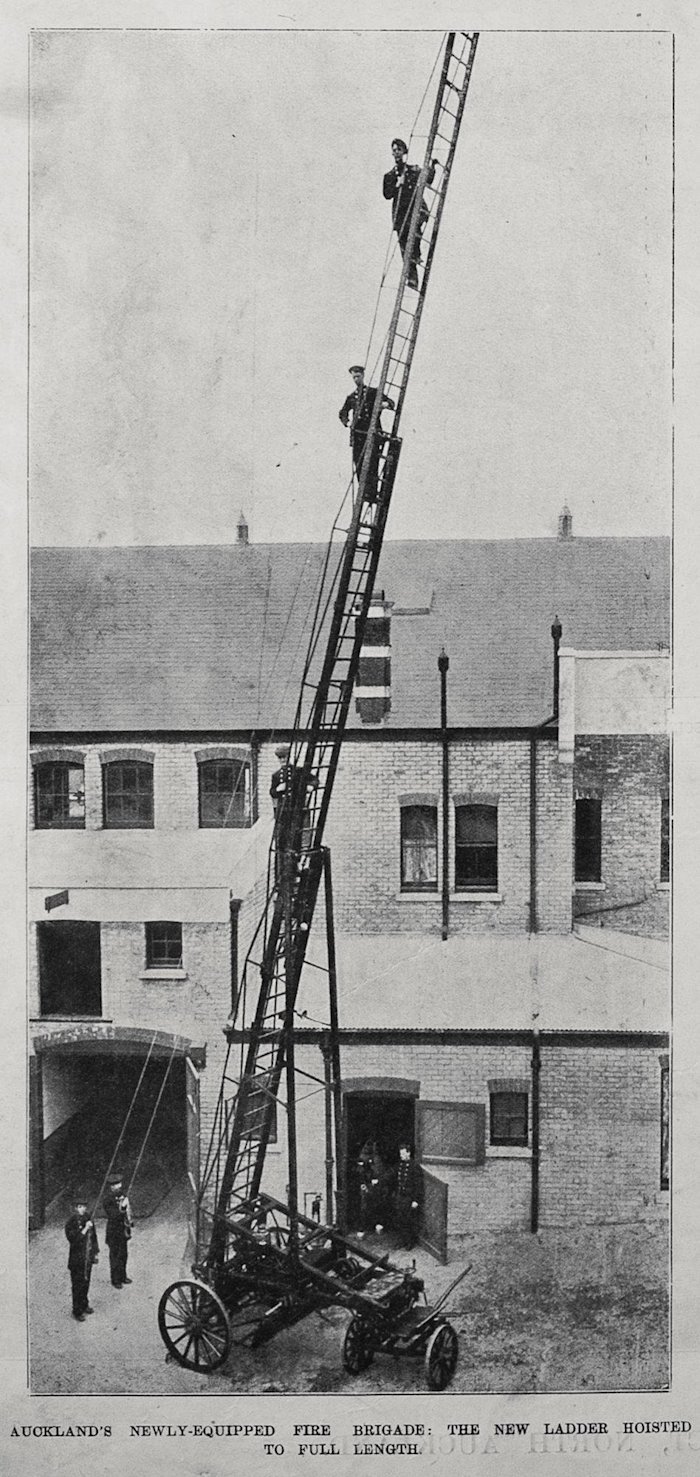
Auckland Weekly News. 30 October 1902. Auckland Libraries Heritage Collections. AWNS-19021030-12-02.
Hugo’s recommendations were undertaken by Auckland Fire Brigade’s newly appointed Superintendent, Charles Wooley, who instigated the purchase of two extension ladders. These were purchased from England, along with a steam fire-pump which was capable of an output of 1 ,500 litres a minute. The first extension ladder purchased was an 80-foot ladder manufactured by Merryweather & Sons of England. The second extension ladder was purchased from Shand Mason Limited, England. Shand Mason had been manufacturing firefighting equipment since 1760 and would eventually be purchased by Merryweather in 1928. Between these two companies they provided the majority of firefighting equipment used in nineteenth century New Zealand.
The Shand Mason Extension Ladder consists of three ladder sections which are attached to a wagon base. At its full height, the ladder could reach up to 65 feet (approximately 20 meters), roughly the height of a six-story building. Once it was wheeled into place, the wagon had large screw-operated brakes which were wound to lock the wheels. A second set of brakes were then implemented to secure the wooden ladder into position. The top two sections of the ladder could be extended by steel cables which were attached to a hand-operated winch. Two firefighters would stand on each side of the ladder, and two more firefighters were required to operate the winch which elevated the ladder sections. In total there were seven hand-operated mechanisms on this Ladder which had to be attended to before firefighters could use the ladder to rescue people or aim hoses onto a fire.
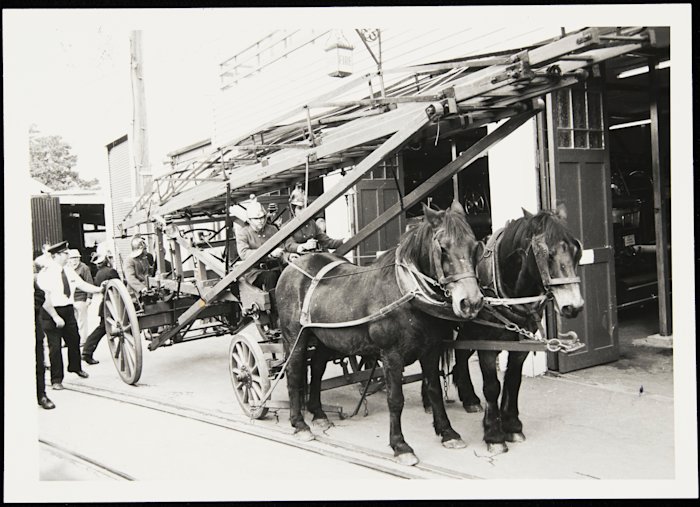
Unknown Photographer. ‘Fire Service: Shand Mason Ladder.’ 04-379 (MOTAT)
The wagon base rolled on four solid-rimmed artillery wheels. The two front wheels were smaller and steerable, articulated with the forward section on a pivot. The bench seat at rear, underneath the ladder and just behind the axle of the larger rear wheels, gave room for two crew additional to the driver. The driver would stay with the wagon for the duration of the fire and was responsible for the horses until they returned to the station.
Nine horses had been purchased by Superintendent Wooley, and they were stabled at all four AFB stations. The Shand Mason Extension Ladder was based at the Pitt Street station and was pulled by two horses. While attending a fire, the driver would be responsible for
the horses, however, once on scene, they were unhitched from the wagon and moved to a safe area away from the flames. All AFB horses required special training so they could run towards fire and not bolt or scare in emergency situations. The horses also had to be strong enough to pull heavy equipment.

Unknown photographer. Auckland Libraries Heritage Collections. 7-A9579
Materials matter
As wood does not conduct heat or electricity it was an ideal material for the AFB’s new equipment. Globally, wood remained the primary material for fire ladders until the 1930s when it was succeeded by aluminum. However, wooden ladders can still be found in fire brigades, for example the San Francisco Fire Department use wooden ladders and have a dedicated woodshop constructing their own bespoke ladders. This preference largely stems from the extensive electric tramlines that cover the city which firefighters must contend with.
Horses were used to transport the ladder until 1918, when they were replaced by a 40-horsepower petrol engine. The first electric ladder had been purchased in 1912 though was not an immediate successor as the battery powered motor proved difficult to recharge. In 1918, the electric battery was replaced with an internal combustion engine which greatly improved its performance and the Shand Mason Extension Ladder became relegated to “reserve” equipment, serving as a training ladder until 1941. Following its time on the front lines it sat in storage until 1964 when it was offered to the Auckland City Council. While they found no use for it, they knew of a new museum that the ladder could find a new home with. It was then presented to the newly formed Museum of Transport and Technology.
Fire Fighting Equipment at MOTAT
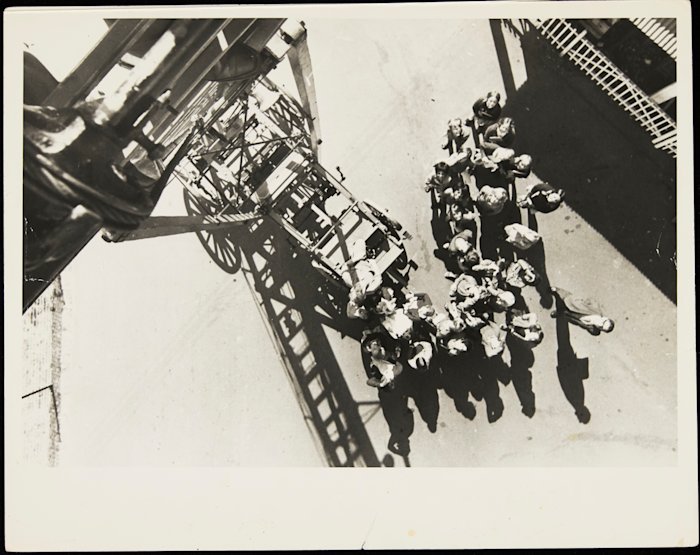
Unknown Photographer. ‘Fire Service: Shand Mason Ladder.’ 04-378 (MOTAT)
MOTAT opened with great fanfare in 1964 with a range of collection items on show for visitors to enjoy. The Shand Mason Extension Ladder was an early fixture in the Fire Service
exhibit, receiving a fresh coat of paint soon after its arrival. Representing machines from the horse-drawn era, it sat alongside the 1868 Manual Pump, also manufactured by Shand Mason Limited, and would later be joined by another Shand Mason Steam Engine manufactured in 1893.
Over the following years the Extension Ladder was wheeled out and extended so visitors could see the hand-operated mechanisms at work, and it even returned one final time to Queen Street during MOTAT's twenty-first Anniversary Birthday parade. A number of vehicles and engines from MOTAT’s collection paraded through Auckland’s city centre to celebrate this milestone. The Shand Mason Extension Ladder was pulled by two Clydesdale horses, though not at the same pace once required of the AFB horses!
While the Shand Mason Extension Ladder has not seen a fire in 84 years it remains a key collection item, demonstrating the breadth of first responder history held at MOTAT.
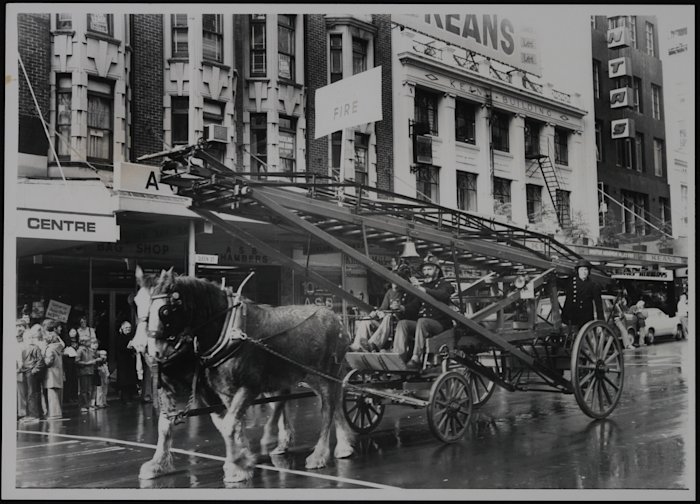
Unknown Photographer. ‘Fire Service: Shand Mason Ladder.’ 05-1508 (MOTAT)
Published April 2025
Story by Susan Tolich, Curator – Transport (MOTAT)
Story edited by Belinda Nevin – Head of Curatorial Research (MOTAT)
References
‘Grand Hotel Fire, 1901 – A Turning Point’ Dispatches. Ric Carylon. 2020.
‘Auckland Before it had a Dependable Fire Brigade.’ Dispatches. Ric Carylon. 2019.
PROTECTION FROM FIRE New Zealand Herald, Volume LV, Issue 16743, 9 January 1918, Page 4
FIRE-FIGHTER RESIGNS New Zealand Herald, Volume LV, Issue 16805, 22 March 1918, Page 7
Auckland Star, Volume XXXII, Issue 213, 19 September 1901, Page 5
LOCAL AND GENERAL NEWS. New Zealand Herald, Volume XLIX, Issue 15034, 2 July 1912, Page 6
‘The Century of the Fire Steed.’ History Magazine, October 1 2011. David A. Norris.
‘The History of Ladders.’ London Fire Brigade. Halima B.
‘Shand Mason and Co.s Steam Fire Engine in Australia.’ Museum of Fire. August 2017.
‘The History of the Wheeled Escape Ladder’ Museum of Fire Heritage Team. October 2013
